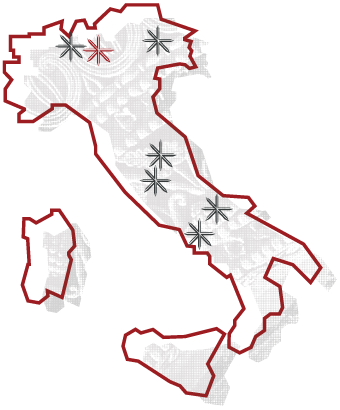Manual Intelligence
Manual Intelligence: Craft Production and Techniques in the Lombard Period
The purpose of this exhibition is to illustrate the productive abilities of the Lombards inItalyand identify the processes that led this people to combine its technical heritage with the Roman-Byzantine patrimony of Mediterranean origin.
TheLombardshad a certain vocation for metallurgy (in line with the rest of the Germanic world’s high technological level of production processes), distinguishing themselves in the manufacture of jewellery, weapons and tools.
At the time of their migration fromPannoniatoItaly(AD 568), theLombards’ metallurgical arts had already largely been perfected; this is shown by the discovery of the graves of blacksmiths/craftsmen, and above all by the high quality of the objects produced and the processing methods employed.
Thus it is not surprising that in the 7th-8th century the blacksmith/craftsman had become important enough to be known by –and sign with – the title of magister.
Possible craft workshops have been identified both in urban and rural contexts, particularly in northern Italy; their presence is also documented by grave goods that include tools of the trade and crucibles. Early Medieval written sources help to clarify the complex scenario of production processes, as do the archaeological discoveries made in the Crypta Balbi workshop inRome.
The metal objects selected to illustrate theLombards’ craftsmanship mostly come from the Nocera Umbra (PG) and Castel Trosino (AP) cemeteries, and were made using various techniques: casting, cloisonné, punching, filigree, damascening, and niello.
Brief reference is also made to pottery production, which has clearly distinctive features.
Date: 24/01/2019 – 21/07/2018
Region: Umbria e Lazio
Town: Spoleto e Roma
Subject: Craft Production and Techniques
The “Lombards in the Limelight” project was organized to make known to a wider public the museums of the seven towns in the serial site (Cividale del Friuli, Brescia, Castelseprio-Torba, Spoleto, Campello sul Clitunno, Benevento, Monte Sant’Angelo), in collaboration with one another and several national museums with Lombard/Early Medieval sections.
This encounter involves 7 exhibition themes, which are divided between the 13 museums listed below.
Museo Nazionale del Ducato di Spoleto
Since 2007 the national museum has narrated the Duchy of Spoleto’s historic, political and cultural development, with a collection of 4th to 15th century AD finds from the city and its surroundings.
Museo delle Civiltà – Museo dell’Alto Medioevo di Roma
The Museo dell’Alto Medioevo was founded to equip Rome with an Early Medieval archaeology museum that recounts the important passage from the Roman world to Late Antiquity. The display includes finds dating from the 4th to 14th centuries, mostly from Rome and central Italy.
Close your eyes and imagine a small funeral procession moving through the fog in front of you, on its way to the church of San Salvatore in Spoleto, and its cemetery.
Silently: women with veiled heads, men wrapped in their cloaks. The cold bites into the flesh, dampness penetrates the bones. But they are there, in the pale light of dawn, to give their last farewell to the master metalworker, the craftsman of their community. As grave goods to accompany him on this last journey, they will put beside him the tools of his trade: the crucible for melting, tongs and tools for bending sheets of iron and granulating gold. In the villages, the metalworker was a person of note.
Other men did not know how to tame metals, forge hooves that allow horses to run fast on any terrain and swords to strike enemies.
The community’s survival depended on his art. The bravest warrior is nothing without 115 116 a shrewd blacksmith who provides him with weapons for battle. But even the people, without a smith, cannot live. The Lombard craftsmen followed the great migrations.
They repaired the wagons’ wheels, shod the horses, produced knives, ladles and jugs, as well as swords and daggers. But they are not just artisans capable of creating everyday objects. In peacetime other materials are worked in their workshops: the glittering metals that are the ornament of power.
They melt and fashion gold and silver, cut precious stones, polish glass and crystals, construct jewel settings. Rings, brooches, buckles, chains, gleaming enamels. All that is beautiful and luxurious is produced by their skilled hands.
They are attentive, tireless, curious, ready to travel to learn new techniques and satisfy new customers. In their workshops, not only metals are alloyed together, but also knowledge: styles are hybridized.
Northern craftsmen encounter southern techniques, and study them, apply them, improve them. They call themselves artifex and magister and these are not just names, but a way of conceiving reality.
Everything passes through the hands of the blacksmith and goldsmith: tools needed for living, jewels that express power, and the gold cross symbolizing a new creed, which accompanies the Lombards on their last journey at death.
And when a blacksmith dies, the village gathers around him, to greet him one last time.
To recognize his role as a maker not only of objects, but of their community and world.
Mariangela Galatea Vaglio


































